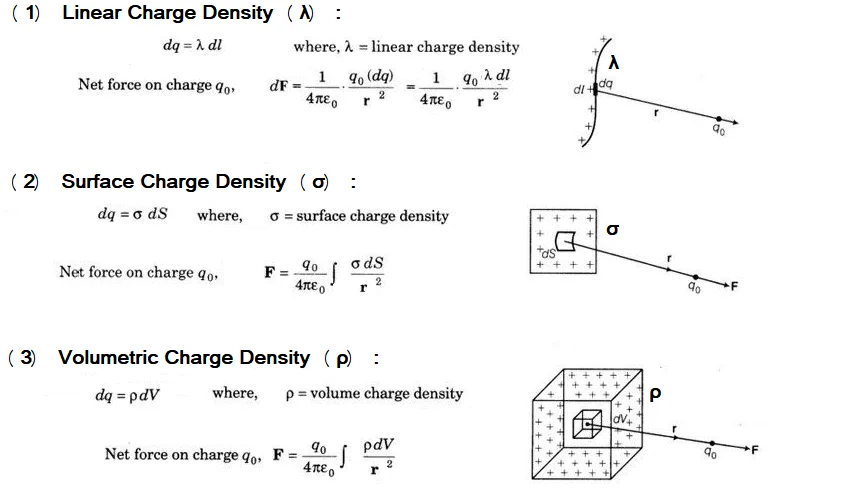3 Type of Continuous Charge Distribution

When electric charge is distributed uniformly throughout a space or surface, the term “continuous charge distribution” is used. In contrast, a discrete charge distribution only has charge at particular points.
Depending on the geometry of the system and the nature of the charge distribution, a continuous charge distribution can take on a variety of shapes. For example, a charged wire or sheet or a charged sphere or cylinder can both be regarded as examples of continuous charge distributions.
To describe a continuous charge distribution, one typically uses one or more types of charge density, such as volumetric charge density, surface charge density, or line charge density.
Table of Contents
Types of Continuous charge distribution:
(1) Linear Charge Distribution :
Linear charge distribution is commonly used to describe the distribution of charge along a wire or other linear conductor (1-dimensional).
Linear charge density: This refers to the amount of electric charge per unit length of a line or wire. It is denoted by the symbol λ.

SI unit of linear charge density is coulombs per meter (C/m).

(2) Surface Charge Distribution :
Surface charge distribution is commonly used to describe the distribution of charge on a surface, such as the surface of a conductor or a dielectric material.
Surface Charge density: This refers to the amount of electric charge per unit area of a surface. It is denoted by the symbol σ.

SI unit of surface charge density (σ) is coulombs per square meter (C/m²).
(3) Volume Charge Distribution :
Volumetric charge distribution is commonly used to describe the distribution of charge within a material or to calculate the total charge contained within a given volume.
Volume charge density: This refers to the amount of electric charge per unit volume of a material or system. It is denoted by the symbol ρ.

SI unit of volumetric charge density (ρ) is coulombs per cubic meter (C/m³).
These different types of charge density are related to each other through the geometry of the system being studied. For example, the total charge contained within a volume can be calculated by integrating the volumetric charge density over the volume, while the total charge on a surface can be calculated by integrating the surface charge density over the surface area. Similarly, the total charge contained along a wire can be calculated by integrating the line charge density along the length of the wire.
Questions from the Topic
How does charge density vary in different materials?
Charge density can vary significantly depending on the material properties and the presence of charged particles or ions. For example, metals tend to have a higher charge density than insulators due to the presence of free electrons that can move around and contribute to the overall charge density.
How does charge density relate to the concept of capacitance?
Capacitance is a measure of a system’s ability to store electric charge. Charge density is directly proportional to the capacitance of a system because the more charge that can be stored in a given volume or area, the greater the capacitance of the system.
How is charge density used to describe the behavior of charged particles in a magnetic field?
Charge density can be used to calculate the current density of a charged particle moving through a magnetic field. This current density, in turn, affects the magnetic field strength and the force experienced by the charged particle.
What is the effect of charge density on the electrical potential energy of a system?
Charge density affects the electrical potential energy of a system because the amount of energy stored in an electric field is directly proportional to the charge density. The higher the charge density, the greater the amount of potential energy stored in the electric field.
MY YouTube Channel Link : 👉🖱 https://www.youtube.com/channel/UCGpC7nWE0-bBv9I53MM8qjQ
3 Type of Continuous Charge Distribution, 3 Type of Continuous Charge Distribution, 3 Type of Continuous Charge Distribution, 3 Type of Continuous Charge Distribution, 3 Type of Continuous Charge Distribution, 3 Type of Continuous Charge Distribution, 3 Type of Continuous Charge Distribution, 3 Type of Continuous Charge Distribution